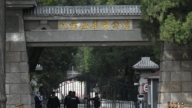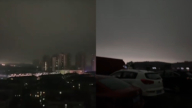【新唐人2014年07月30日讯】中国“人力资源和社会保障部”上周五表示,二季度末,城镇登记失业率为4.08%,不过在此之前,“国家发展和改革委员会”公布的失业率数据,高出上面“人社部”的失业率一个百分点。诡异的是,发改委很快删除了这一数据。经济学家指出,中共官方公布的城市失业率毫无意义,因为不管经济好坏,失业率永远不会改变,总维持在4%。
在中国“人力资源和社会保障部”发布第二季度失业率的前一天,美国《华尔街日报》就评论说,中共官方公布的失业率被广泛视为无用,因为不管好日子、坏日子,它几乎都不动。这个数字,只涵盖那些在本地福利中心注册的工人,而不包含大量的农民工。
中国浙江财经大学教授谢作诗:“整体来说,我们的失业率一直是在4左右,多年来,不管经济形势好坏,始终都是在4左右。所以首先这个数字真实性怎么样,大家有些想法。第二个问题是,它是一个城市登记失业,如果是农民工,他不进入这个口径,从这个意义上讲,这个失业率和国际上一般的失业率不是一个概念,它对中国经济形势的反映,就不那么全面,不那么准确。”
2008年,当全球金融危机摧毁3千万中国制造业就业的时候,这个失业率几乎没有怎么升高。大量农民工回到农村家乡,泄漏了失业的真实程度。
《华尔街日报》评论说,中国真实的失业率是一个国家机密。北京领导人每个月审视一个单独的就业调查,但是这个数据通常不公布。在四月份,一名官员说漏嘴,说失业率是 5.17%,这比官方公布的数字高出一个百分点。
中共总理李克强本人在去年9月一篇专栏文章当中提及失业率,当时他说2013年上半年失业率是5%。
“发改委”上周三公布,6月末,全中国31个大城市城镇调查失业率为5.05%,这也是中共官方首次正式发布城镇调查失业率数据。“发改委”声称,这个数字已经连续4个月下降。可是,这个消息目前已从“发改委”网站撤下,相关网页已无法打开。
中国“浙江财经大学”教授谢作诗认为,所谓失业率连续四个月下降的说法,跟民众的直观感受相差太远。谢作诗身边的企业家都在谈论裁员。
谢作诗:“短期现在经济形势困难,困难的话应该失业率上升才对,对大家的直观感受太差,就可能引起大家的怀疑,大家觉得你这个数据是不是真实的。我昨天还跟好几个企业老总吃饭,大家想到的都是裁员,其中有一个老总说,他再挺两个月不行,他要裁一百人。”
针对“发改委”删除近期的失业率,北京“天则经济研究所”所长助理段绍译分析说,或许这个数字对于官员来说仍然太过刺眼。
北京天则经济研究所所长助理段绍译:“因为一个失业率的高低,它一方面反映经济的景气(程度),另外反映地方政府官员的政绩,中国考核指标有时候可能造成影响社会安定,数据太高的话,造成老百姓对政府不满,所以有些数据还是不宜让老百姓知道,他们不一定希望让老百姓知道。”
据《中国证券网》报导,今年全国高校毕业生总数达到727万人,创下历史新高,堪称“史上最难就业季”。“人力资源和社会保障部”新闻发言人李忠介绍,上半年有97万求职者与用人单位达成就业意向,其中高校毕业生56万人。56万仅仅是727万毕业生中的7%,不足一成毕业生就业,高校毕业生就业压力巨大。
澳大利亚杂志《商业旁观者》,7月21号发表有关中国失业率和劳工短缺的文章。作者根据一项全中国劳动力调查和就业辅导机构的统计数字,计算102个大城市的失业率,结果,在今年第一季度,包括农民工在内的大城市失业率为8.7%﹔排除农民工的失业率为6.9%。而今年第一季度之前的失业率也接近这个数字,暗示高失业率一直持续。
采访编辑/秦雪 后制/肖颜
The CCP Replaced The Five Percent Unemployment Rate Report With A Four Percent Version
On Friday, the Chinese Communist Party’s (CCP) Ministry
of Human Resources and Social Security (MOHRSS) said
that the registered unemployment rate will be 4.08 percent
in Chinese cities by the end of 2014 second quarter.
The figure is 1 percent lower than that announced earlier
by the CCP’s National Development and Reform
Commission (NDRC).
Strange is that the NDRC quickly deleted reports
about the previously announced number.
Economists comment that the CCP’s official urban
unemployment rate is meaningless as it is always
around 4 percent and never changes no matter
how China’s economy looks.
One day before the MOHRSS announced China’s quarter two
unemployment rate, the Wall Street Journal published
an article saying the CCP’s official unemployment rate
is widely regarded as a meaningless number.
The report says the number almost never changes
under any circumstances.
The number announced by the CCP only counts for those
employees registered at local social welfare center,
and does not take into account the large group
of migrant workers.
Xie Zuoshi, Professor at Zhejiang University of Finance
and Economics: “Our overall unemployment rate is always
around 4 percent these years, no matter how
the economy looks.
Therefore whether the number is real or not,
our people are in doubt of it.
In addition, the number refers to ‘registered urban
unemployment.’
Migrant workers from the countryside are not
included in that system.
In this sense, our employment rate is defined differently
then the one used in the world.
The index is thus not a comprehensive or accurate indication
of China’s economic situation.”
In 2008, the global financial crisis destroyed 30 million jobs
in China’s manufacturing industry.
However, the official employment rate saw little increase.
However, China’s real employment picture was clearly
shown by the massive home rush of migrant workers.
The Wall Street Journal article commented that China’s
real unemployment rate is a “state secret.”
Beijing’s party leaders look at an independent employment
report every month, which is never made public.
In April, a CCP official spilled the beans when he said
the unemployment rate was 5.17 percent.
A number 1 percent higher than that which was
previously announced.
The CCP premier Li Keqiang also mentioned the figure
in a column published last September.
Li said China’s unemployment rate was five percent
in the first half of 2013.
Last Wednesday, the CCP’s NDRC announced that
by late June the urban unemployment rate among
31 major Chinese cities was 5.05 percent.
This was the first time that the CCP officially announced
urban unemployment statistics.
The NDRC said the rate had dropped
for four consecutive months.
However, the news was later removed from
the NDRC website and was no longer available online.
Xie Zuoshi, professor at Zhejiang University of Finance
and Economics, says a drop in the unemployment rate
in the last four months does not conform
to what the Chinese public sees.
All of Xie’s friends were talking about layoffs
during the period.
Xie Zuoshi: “Now we have economic troubles
and the unemployment rate should rise in such case.
Therefore our people are in doubt of the authenticity
of the number, as it complete deviates from their intuitions.
Yesterday I had dinner together with several
enterprise managers.
All of them were talking about layoffs.
One of them said if nothing turns around in the next
two months he would have to fire 100 employees.”
Assistant Director of Beijing Unirule Institute of Economics
Duan Shaoyi comments on the NDRC’s taking back
of its unemployment rate report.
Duan says probably a rate of five percent was still
too “dazzling” for the CCP officials.
Duan Shaoyi: “The reason is, the unemployment rate
not only reflects the economic situation, but also relates
to the local official’s political record.
The CCP always has concerns over the effect
of those indicators on social stability.
If the reported unemployment rate is too high,
Chinese civilians will grow more discontent with the CCP.
Therefore they don’t want to publicly reveal
the real figures.”
Cnstock.com, a Chinese stock website, reported that a record
high 7.27 million will graduate from Chinese colleges
this year.
This makes 2014 “the most difficult year to find a job.”
The CCP’s MOHRSS spokesman Li Zhong says 970,000 job
applicants successfully signing contracts with employers
during the first half of 2014.
Among those applicants, only 560,000 are college graduates,
which is only seven percent of 7,270,000.
With less than 10 percent of graduates getting jobs,
the employment pressure is unprecedentedly huge.
On July 21, Australian magazine Business Spectator
published an article about China’s unemployment rate
and labor shortage.
The article estimates the unemployment rate in 102 major
Chinese cities according to a nationwide labor survey
as well as statistics from job placement services.
The author finds that, “The unemployment rate,
including rural migrants in major cities in the first quarter
of 2014, is 8.7 percent; excluding them is 6.9 percent.”
“Unemployment rates before the first quarter of 2014
are also close to these numbers, suggesting
the continued high unemployment rate.”
Interview & Edit/QinXue Post-Production/XiaoYan

























